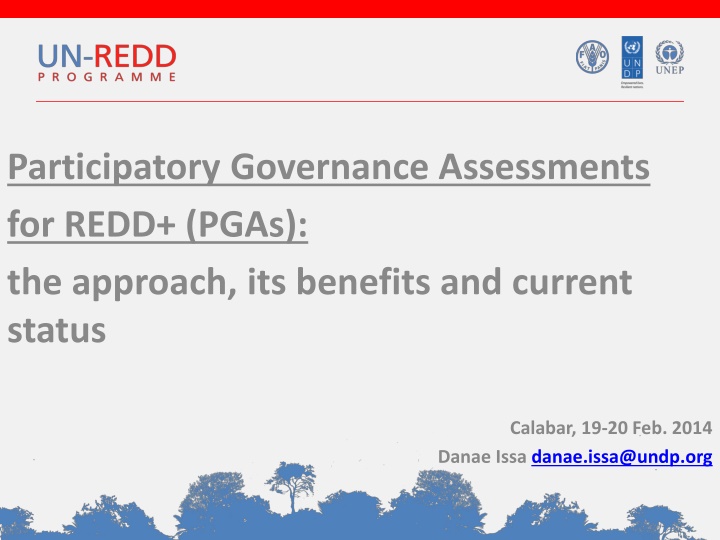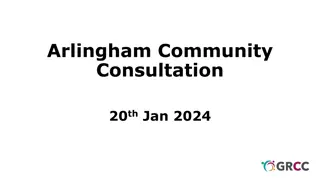
Faith-based Community Development: Role & Initiatives
This content discusses the significance of faith-based institutions in community development, focusing on the history, major initiatives, and the role of Community Development Corporations (CDCs) in revitalizing neighborhoods. It highlights the involvement of churches, community organizations, and government initiatives in empowering communities of color through faith-based initiatives.
Download Presentation

Please find below an Image/Link to download the presentation.
The content on the website is provided AS IS for your information and personal use only. It may not be sold, licensed, or shared on other websites without obtaining consent from the author. If you encounter any issues during the download, it is possible that the publisher has removed the file from their server.
You are allowed to download the files provided on this website for personal or commercial use, subject to the condition that they are used lawfully. All files are the property of their respective owners.
The content on the website is provided AS IS for your information and personal use only. It may not be sold, licensed, or shared on other websites without obtaining consent from the author.
E N D
Presentation Transcript
Participatory Governance Assessments for REDD+ (PGAs): the approach, its benefits and current status Calabar, 19-20 Feb. 2014 Danae Issa danae.issa@undp.org
Definition of Governance GOVERNANCE Governance is defined as comprising the mechanisms, processes and institutions that determine how power is exercised, how decisions are made on issues of public concern, and how citizens articulate their interests, exercise their legal rights, meet their obligations and mediate their differences
Democratic Governance (UNDP Definition) Democratic governance means that people have a say in the decisions that affect their lives and that they can hold decision-makers accountable. It further entails that the rules, institutions and practices that govern social interactions are inclusive and fair, that women are equal partners with men in private and public spheres of life, that people are free from discrimination based on race, ethnicity, class, gender or any other attribute, and that the needs of future generations are reflected in current policies. It also means that economic and social policies are responsive to people s needs and their aspirations, that these policies aim at eradicating poverty and expanding the choices that all people have in their lives, and that human rights and fundamental freedoms are respected.
Exponential growth of governance indicators industry over the last 2 decades World Governance Assessment Global Accountability Report Gender Empowerment Measure Press Freedom GAPS in Workers Rights Global Integrity Index BEEPS Index of Economic Freedom East Asia Barometer Bribe Payers Index Opacity Index Commitment to Development CIRI Governance Matters Human Rights Database Global Eurobarometer Afrobarometer Competitiveness Index Polity Bertelsmann Transformation Index Media Sustainability Index CPIA (WB) International Country Risk Guide Corruption Perception Index Journalists killed Freedom in the World Open Budget Index 1974 76 78 80 82 84 86 88 90 92 94 96 98 00 02 04 06
What are the objectives of governance assessments? Examples: External assessments:by development partners, independent research institutions, private sector companies,... -To make decisions on investment -To make decision on aid allocation, development support plans - strategic information for foreign affairs decisions;... But limitations on ownership and national capacity development Peer assessments: assessment of a state by other states (peers) on a voluntary basis e.g. African peer-review mechanism among AU members National or local assessments: - To understand the causes of a problem and obstacles to reform (bottlenecks), or factors for success of policies - Evidence-based policy-making - Understand the impact of certain governance issues on a specific sector or population groups and design solutions
Country-led Participatory Governance Assessments: Are undertaken by a country on its own initiative Can be conducted by government, parliament, CSOs, academic institutions, media organizations, or a coalition of different entities Can monitor different aspects of governance (comprehensive, sectoral, local ) Include participation of both State and non-State actors Influence political decision-making and policy-making
The double purpose of participatory governance assessments: Strengthen the supply of governance (evidence-based policy-making) PARTICIPATORY GOVERNANCE ASSESSMENT Strengthen the demand for governance (accountability mechanism)
4 fundamental principles: Accountability: Country-led assessments act as a critical accountability mechanism for governance performance to local stakeholders. Participation: A broad and representative range of national actors have opportunities to input into key stages of the assessment process. Transparency: National actors have unbiased access to information on the assessment process and the results of the assessment are made available to the public as a public good. Legitimacy: National actors agree that the assessment process and its results are legitimate and should be followed.
10 characteristics Assessment is aligned to national political priorities, such as NDP Assessment is country contextualized Methodology is rigorous Selection of indicators is transparent and participatory Results are stored in a public national database Indicators are pro-poor and gender-sensitive Capacity of national stakeholders are developed The assessment is cost-effective and timely The results are widely communicated The assessment is repeated
A PGA IS A PROCESS Identify national institution or civil society organization for hosting initiative Conduct multi- stakeholder dialogue on governance priorities Establish a steering committee Identify key stakeholders Raise funds Decide on how to collect the data Decide on assessment framework Select type of assessment Decide on who will do the research Decide on sampling Decide on indicators Institutionalize the assessment and repeat at regular intervals Conduct multi- stakeholder consultation Develop policy recommend- ations Conduct policy reform or advocate for reform Analyse results Disseminate results
Added value of participatory process Technical benefits and political benefits Local relevance of the information: provides information that is actually needed and demanded by the concerned stakeholders Actionability of indicators Ownership by actors accountability: increases the likelihood that actors will follow-up on the recommendations and take actions based on the information Consensus-building and political will: process may strengthen political dialogue Sustainability Continuation of the dialogue and institutionalization of the assessment over time, towards an improvement of the country situation Legitimacy when all stakehoders concerned have participated in taking decisions at all steps of the process, they are more likely to trust the process and its results, and consider the information legitimate Public trust in the exercise which is public and transparent Better use of indicators in planning by different entities Increase impact of assessment
Relevance of PGAs to REDD+ For government: to highlight areas in need of urgent attention and prioritize action; to provide relevant information on governance for policy-making and planning at national and sub-national level; as a basis for political reform; as governance data that can aliment the National Safeguards Information System, to be transmited to the UNFCCC; to monitor progress and regression if regularly updated. For civil society: Consistent information on governance that can be used for advocacy and demanding accountability to decision makers Data validated by the government, which avoids debates on the accuracy on the information and allows to move forward in the dialogue between civil society and government To monitor progress or lack thereof
REDD+ safeguards (a) Policy coherence (national & international) (b) Forest governance (transparency & effectiveness) (d) Full and effective participation of relevant stakeholders (c) Knowledge and rights of indigenous peoples & local communities (e) Conservation, biodiversity, social & environmental benefits (g) Carbon leakage risks (f) Permanence
Participatory Governance Assessments (PGAs) for REDD+ PGAs for REDD+ UNDP FAO experience on governance assessments experience on forest data collection
Pilot PGA for REDD+ projects INDONESIA NIGERIA VIETNAM ECUADOR Establish organizational structure Identify governance issues Develop indicators framework Analyze and disseminate results Collect data
Knowledge resource on PGAs for REDD+ Practical Guide on PGAs for REDD+ (to be published soon): Importance of governance for REDD+ PGA approach Concrete indicative steps to conduct a PGA: 1: Preparation 2: Structural Design and Joint Decision Making 3: Indicator Development and Data Collection and Analysis Determining Components Developing Indicators Data Collection Methods Validation and Analysis of Data 4: Communication of Results and Use of Data
Step 1: Preparation Start identifying potential end-users, how to best communicate results and which institution will be best placed to update PGA data regularly in the long run; Map current governance initiatives to avoid overlap and identify potentially relevant data sources Map and identify relevant stakeholders Step 2: Design and joint decision Agree on how the PGA can be structured and organized (management structure) Determine the geographical scope (national and/ or local level), Raise awareness on the PGA among key stakeholders Prioritize governance issues to be covered by a PGA for REDD+ Agree on a general roadmap/ milestones for the PGA process Step 3: Data collection, validation and analysis Discuss options and agree on appropriate data collection methods Stakeholders to validate the data and the preliminary analysis before launch Develop indicators based on the governance issues prioritized Refine the indicator set Collect data as agreed if/ as appropriate Step 4: Communication of results and use of data Use of data and follow- up of recommendations Institutionalize the assessment by identifying insitution responsible for future data updates and dissemination Disseminate data set, key findings and policy recommendations through launch and methods agreed to reach all stakeholders Demand for further technical support to be determined by stakeholders - repeat at regular intervals
And in Nigeria... So far: PGA Committee created Priority governance issues identified Draft indicator set elaborated First PGA cycle to be completed this year 1. Broad and informed participation of REDD+ stakeholders 2. Harmonization of policy and legal framework for REDD+ 3. Transparency and accountability of the REDD+ process and finance 4. Inter-governmental relations and coordination Draft indicator set available PGA/REDD+ Committee Current status Establish organizational structure Identify governance issues Develop indicators framework Analyze and disseminate results Collect data






















